ITPG-GT 2040 – 001 (23548)
[Home | 02023 Syllabus | Ideas | Resources | Gallery]
- Notes on the Syllabus
- Office Hours
- Student Documentation
- Assignments
- Readings
- Syllabus
- Class 01, September 1 – Gnomon
- Class 02, September 08 – Ecliptic
- Class 03, September 15 – Astraria
- Class 04, September 22 – Existing in Time
- Class 05, September 29 – Seeing Time
- Class 06, October 06 – Data to Meaning
- Class 07, October 13 – Cepheid Variables
- * Class 08, October 20 : Midterm *
- Class 09, October 27 – The Copernican Principle
- Class 10, November 03 – $_TIME
- Class 11, November 10 – Space Lasers
- Class 12, November 17 – Final Workshop
- Thanksgiving Break, November 24
- * Class 13, December 01: Finals I *
- * Class 14, December 08: Finals II *
- Class Policies
Notes on the Syllabus
This is a production course about big ideas. I’ve tried to organize the syllabus to interlace conceptual and technical topics, as I want to provide new tools for interesting work along with thought-provoking ideas to fuel your creativity. As often as possible, classes will have both. There is so much a Time class could cover; I’ve tried to filter for material that is actionable, inspiring, and important. That sill leaves way more than can fit in fourteen weeks. Nevertheless…
For weeks one through six, there are three two-week production assignments (sundial, clock/watch, time-based media). You will develop one of these into a fuller midterm presented in week 8. After that your production output will focus on a final project. We will also read and look at examples of art throughout the semester.
Office Hours
I have an NYU office hour calendar and will be posting hours there when the semester begins.
Student Documentation
As is typical at ITP, please document your work for this class online. Set up a URL that shows only work for this class – if you’re using a blog, have a tag or category for the class, for example. Document early and often – more frequent rough-draft posts are better than fewer super polished ones, and help me understand your progress in the class. An assignment or project should have a final post that captures the work, including references.
I will use a shared class spreadsheet to compile things like links to your documentation. Access the doc through your NYU account.
Assignments
Deliverable schedule
An overview of what is due when. For more detail, see Assignments and Readings
- Sundial, progress post week 2, final post week 3 (September 15)
- Clock, progress post week 4, final post week 5 (September 29)
- “Seeing Time”: time-based media, progress post week 6, final post week 7 (October 13)
- Midterm, presented in class week 8 (October 20)
- Final project presented in class week 13 or 14 (December 1 or 8)
- Reading facilitator – one week scheduled between weeks 3 and 12 inclusive (September 15-November 12)
- Art share – one week scheduled between weeks 3 and 12 inclusive (September 15-November 12)
Production Assignments
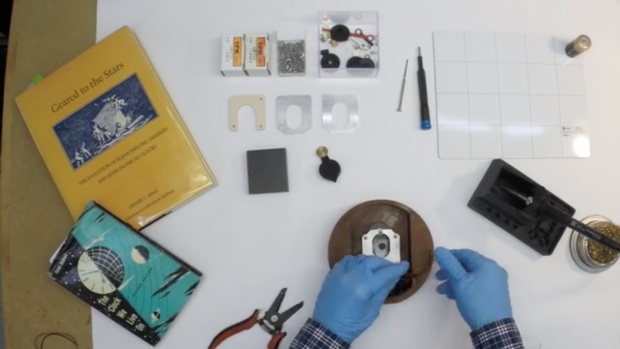
For weeks one through six, there are three two-week production assignments (sundial, clock/watch, time-based media). You will develop one of these into a fuller midterm presented in week 8. After that your production output will focus on a final project.
Please feel free to interpret prompts literally or with a wide degree of latitude. You may work in groups of two or three; if you want to do a larger group, see me first. Feel free to use assignments to support work in other classes as long as you address the brief.
1 – Sundial
Make a sundial. “Sundial” can be a metaphor. Make and document a prototype for class two, and improve the sundial for class three.
Due: documented online by class three (September 15).
See Ideas on Sundials.
2 – Clock/Watch
Design a working watch or clock face in code or hardware. The clock can be a bad clock. Create two to four drafts by class four, and finalize a design by class five.
Due: Documented online by class five (September 29).
See Ideas on Watch Face Design.
3 – Seeing Time
Create time-lapse, slow-motion, or deep-nostalgia media. Use video, code, or audio.
Due: documented online by class seven (October 13)
See Ideas on time-based media.
Midterm
Develop one of the initial projects further for presentation in class in week 8. In your documentation for the midterm, include at least three text sources, which could be passages from the Rovelli and Griffiths books, or other readings; and one or more related or inspiring art works.
Due: Presented in class and documented by class eight (October 20).
Final
I believe constraints make for good work, but I also feel the initial rapid projects are already reasonably constrained. So for your final project, I ask you to create the constraints yourself, as long as the project is related to Time and demonstrates creative and technical excellence. I will check in with you throughout the semester (in and out of class) to discuss progress towards final projects. Elaborating on an earlier project – from this class or others – is perfectly fine, as is working in groups up to three people (larger, please see me).
In your documentation for the final, include at least six sources, which could be passages from the Rovelli and Griffiths texts, or other readings; and two or more related art works.
Presented in class weeks 13 (December 1, software projects) and 14 (December 8, hardware projects). Final schedule TBD depending on type and number of projects.
Reading facilitator
You will sign up for one week to lead the reading discussion (5-10 minutes), drawing from the assigned reading (Rovelli, Griffiths) or other additional readings posted in the syllabus. One day prior to your scheduled class you will post 1-2 topics for discussion to the shared class document. More than one student may be scheduled for a given week.
Art share
You will sign up for one week to share art related to the class. This could be a specific piece you’ve seen IRL or online, an artist with an interesting body of work, etc. One day prior to your scheduled class you will post a link to the work in the shared class document. More than one student may be scheduled for a given week.
Readings
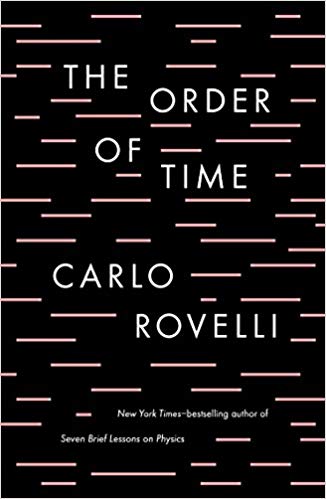
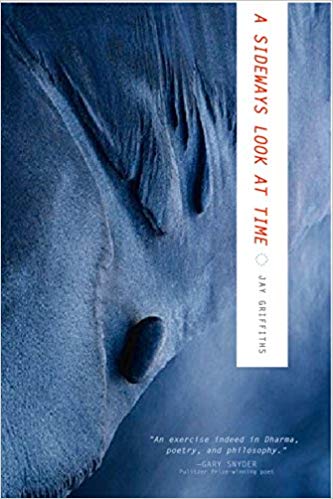
We’ll be reading two primary texts for this class: Carlo Rovelli’s small, beautiful book, The Order of Time, and Jay Griffiths’ wide-ranging and thought-provoking work A Sideways Look At Time (also known as “Pip Pip” in the UK).
Rovelli is a physicist with a poet’s sensibility, and he presents a scientific view of time that is approachable and moving. The text is available to read online through the NYU library, although I recommend a hardcopy, as it is cute, and has extensive end notes. It is a small book that can be read cover to cover in a few days.
Griffiths covers everything outside the scientific efforts to measure time: time in politics, power, culture, gender, and more. It should be read differently from the Rovelli. In my experience, it seems to alienate some students while exciting others. Feel free to jump into the text at random. Find two or three chapters that really resonate with you and focus on those.
(02022 note – The Griffiths reading is getting harder to find in print. You may have luck on Amazon. There is an excerpt from her book on her website, and I’ve transcribed a beautiful passage from her interview in the documentary Keeper of Time. Start here if you’re having trouble finding the text.)
New for 02022! I have added a ton of notes in written form on the Ideas page. Take a look! It’s not over-organized, nor could it ever pretend to be complete, but if you familiarize yourself with the posts there we will jump start in-class conversations and you’ll have a lot of pointers to further reading and research.
I will augment the main texts with a collection of readings linked throughout the syllabus. I may also add links to specific smaller readings (articles, papers, etc) in the syllabus based on what comes up in class discussions.
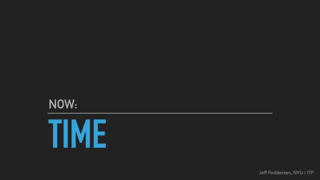
Throughout the semester I will use slides to illustrate points, guide discussions, and generally help me organize the material I want to cover in each class. These are generally not designed as stand-alone documentation; however, to the extent they will be useful I will share drafts with the class. If anyone has difficulty seeing the material in class or accessing it when shared, please let me know so we can work out how best to get the material to you. You can see last year’s slides from that syllabus; I will modify or update these as I prep material for this year.
Syllabus
Class 01, September 1 – Gnomon
Who are we? What are we doing?
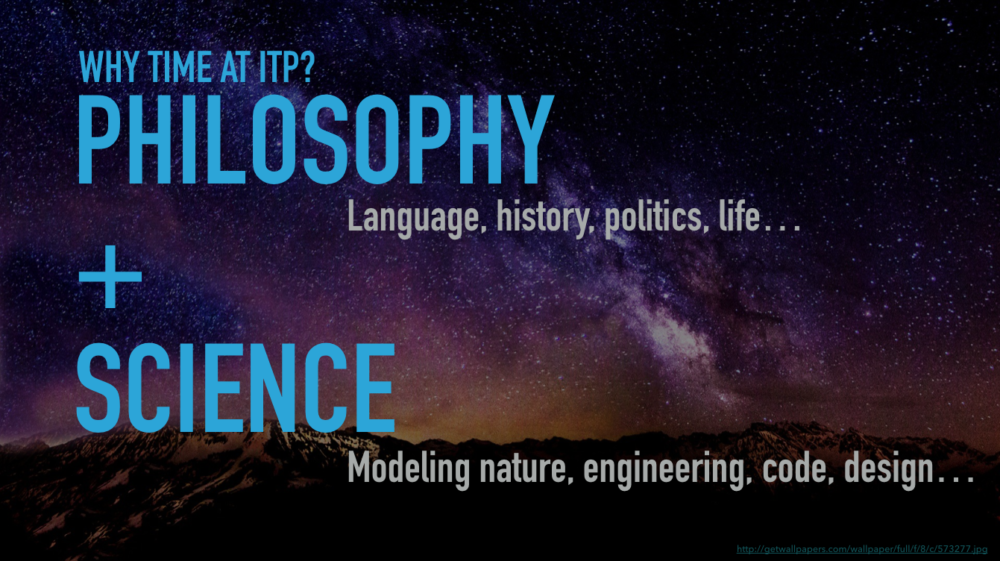
Topic: Introductions, “The Gnomon”
Technical material: Elevation and Azimuth
In-class activity: Human planetarium
Do before next class: Set up documentation and put URL in class spreadsheet. Get the primary text books (For a preview, see this Rovelli interview and Griffiths excerpt). Review syllabus, especially ideas and technical resources, and extra especially sundial notes. Complete this intro survey form.
Production assignment: Sundial
Resources: Stellarium, Suncalc and Mooncalc. Make sure to set location to 370 Jay Street, and time to 1PM EDT today. Find coordinates as Azimuth and Altitude or Elevation (as opposed to Right Ascension and Declination). Use compass and level apps to find direction towards sky object. Set compass to use true (not magnetic) north. Use anything (paper + tape, your arm, anything) as pointers.
Class 02, September 08 – Ecliptic
How does the sky work?

Topic: The Ecliptic
Technical material: Review of useful parts for class. See the Resources page for useful hardware and software.
In-class activity: Which way is your time?
Do before next class: Begin reading Rovelli, and skim Griffiths for chapters of interest. Listen to (or read the transcript) of this interview with Lera Boroditsky on Language, Thought, Space and Time.
Production assignment: Sundial continued.
Resources:
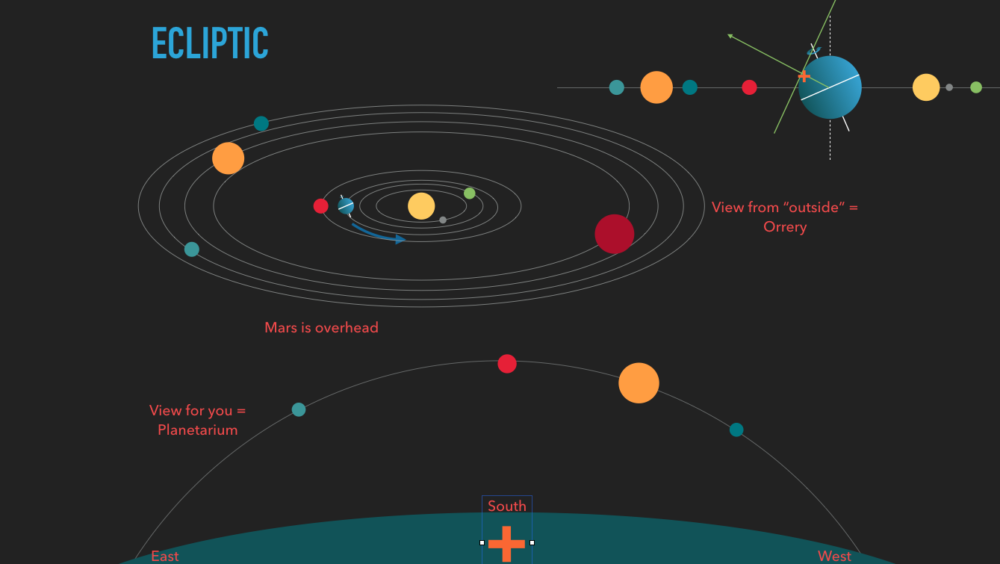
Class 03, September 15 – Astraria
Clocks are cool
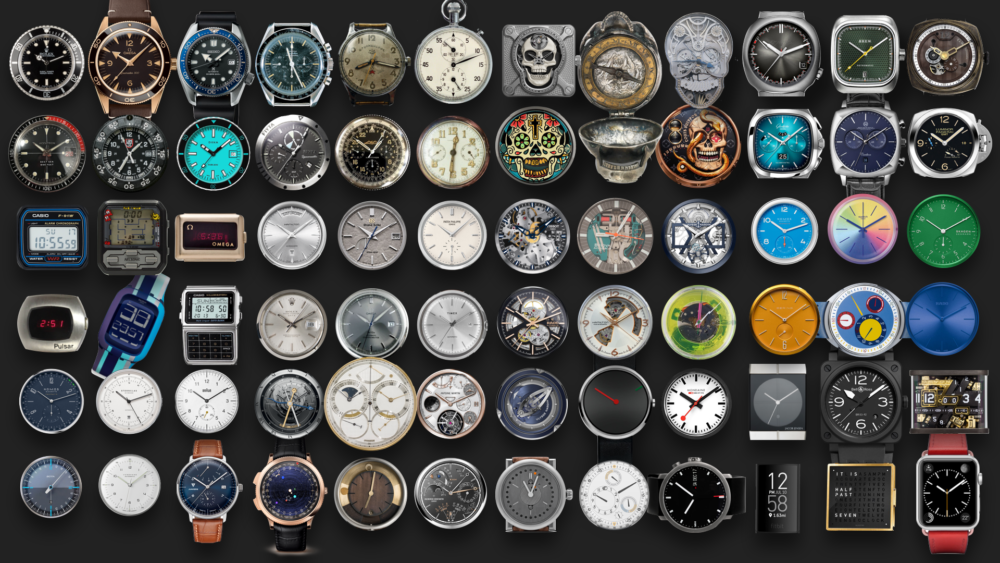
Topic: Ecliptic continued, transitioning to all the beautiful items people have crafted inspired by the moving heavens.
Technical material: Watch face design notes, useful parts continued wrap up (if necessary)
In-class activity: Quick sundial review (2-4); download libraries for Greensock and/or Func (JS) Ramp and/or Tasker (Arduino)
Do before next class: Continue Rovelli reading, section two. Continue sampling Griffiths. Read notes on watch faces as small multiple design. Watch the videos linked under Resources.
Production assignment: Start watch/clock design.
Resources: Week 2 slides download has continuation of this presentation.
A zip of the Arduino code with Ramp and Tasker examples. Demo videos from 2020 (private for class, password is orrery). Ramp, Tasker, Next Level
Class 04, September 22 – Existing in Time
Is code the most time-based art form?
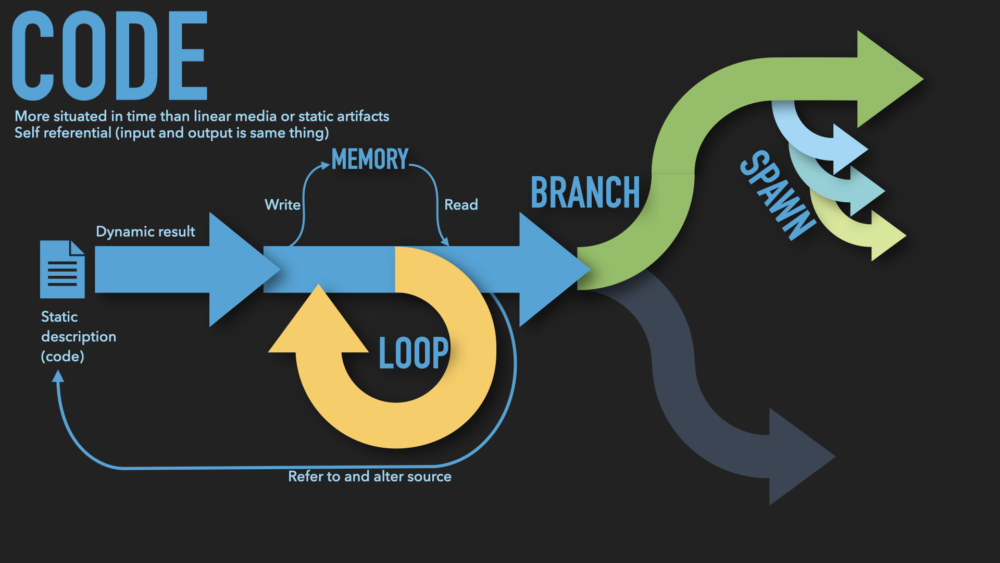
Topic: Existing in Time
Technical material: Timelines and tweens
In-class activity: Adding easings and timelines to our clock code. Wrist check – how do you tell time?
Do before next class: Continue Rovelli reading, section three. Read notes on Seeing Time.
Production assignment: Watch/clock continued.
Resources:
Class 05, September 29 – Seeing Time
How do you see time?

Topic: Seeing Time.
Technical material: Timelines and tweens continued (if necessary)
In-class activity: Brief watch/clock review (3-5)
Do before next class: Finish Rovelli reading. Continue Griffiths reading. Read notes on Data to Meaning and RTCs.
Production assignment: Begin time-based media
Resources:
Class 06, October 06 – Data to Meaning
How does data become information?
Topic: Data to Meaning
Technical material: RTCs
In-class activity: Dissecting Delay
Do before next class: Catch up on readings, projects and posts.
Production assignment: Time-based media continued
Resources:
Code examples used in class (may not get to all):
These include:
InterruptStudy
– Uses encoder (which in turn uses interrupts internally), plus custom interrupt for button, plus structs for keeping various independent timers
AccelerometerWithAveraging
– Uses onboard IMU from the Nano 33 as a source of noisy real world analog data. Shows various filtering techniques to derive more “high-level” events from low-level raw data
BasicInterrupt
– Minimal button handling interrupt example
ds3231RTC
– Boilerplate RTC code using Adafruit library
ds3231DemoWithOled
– Boilerplate RTC code using Adafruit library, with OLED display
SimpleButtonMeaningClassifier1, 2, 3
– Shows increasingly higher-level classifications of button presses.
Time machines, data to meaning slides:
Class 07, October 13 – Cepheid Variables
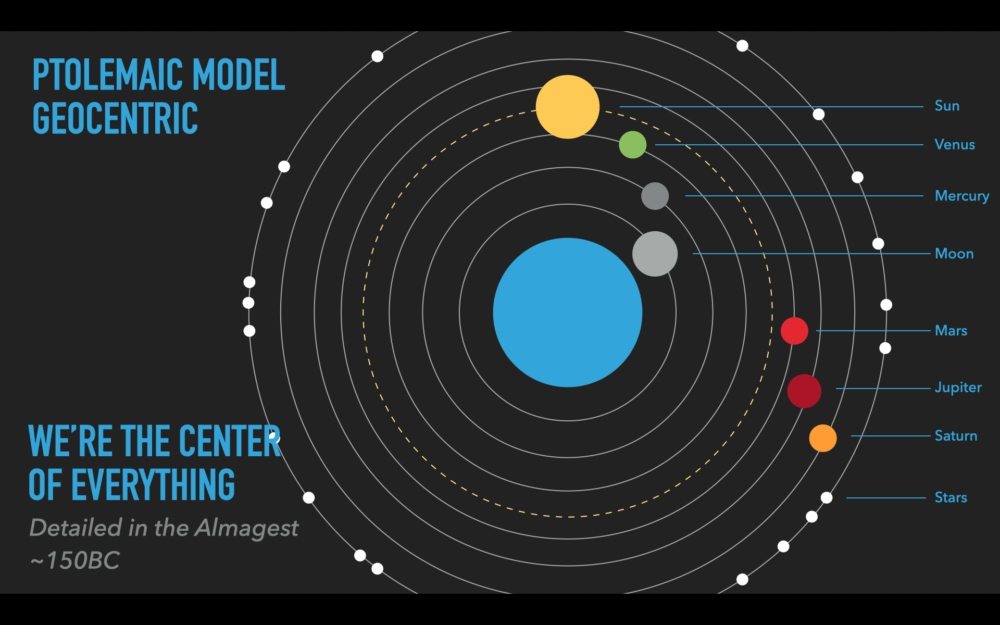
Topic: The size of the universe.
Technical material: Midterm workshop.
In-class activity: Brief time-based media review (2-4).
Do before next class: Finish your midterm.
Production assignment: Midterm
Resources:
The iconic 1977 film “Powers of 10” by Charles and Ray Eames for IBM. Around minute two, note: “A line extends at the true speed of light, in one second half-crossing the tilted orbit of the moon.”
* Class 08, October 20 : Midterm *
In-class activity: Midterm project review
Do before next class:
Production assignment: Final
Resources:
Class 09, October 27 – The Copernican Principle
When are we?
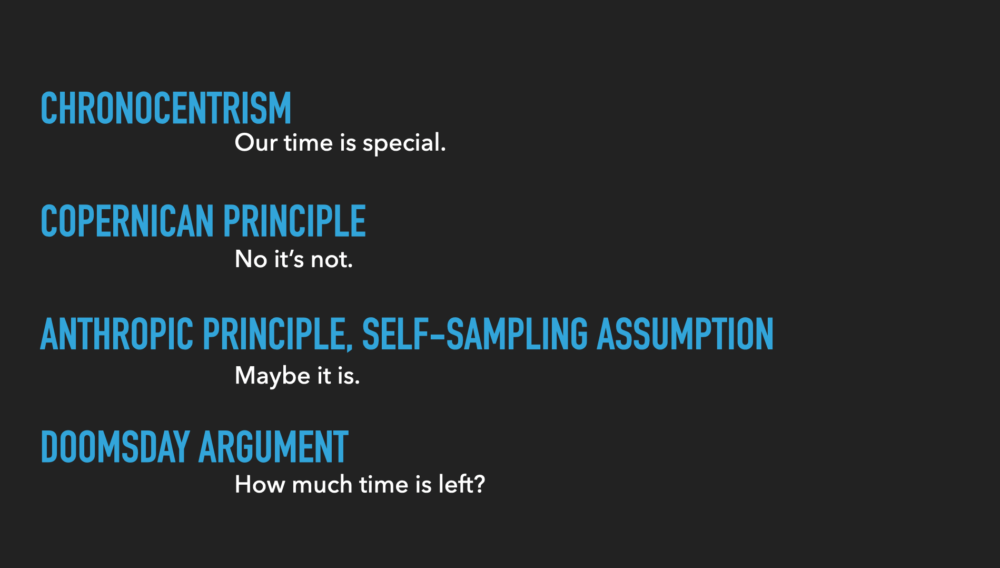
Topic: Ideas for trying to locate ourselves in time.
Technical material: AMA
In-class activity: Drawing the future
Do before next class: Prepare a blog post on your final project. What will you do? Preview the Buying Time material (below) for discussion.
Production assignment: Final
Resources:
Class 10, November 03 – $_TIME
Who owns time?

Topic: Time and labour, time and freedom, time and power.
Technical material: AMA
In-class activity: Buying time discussion.
Do before next class: Think about your favorite representations of time in pop culture – movies, music, etc. to share next week.
Production assignment: Final
Resources:
Class 11, November 10 – Space Lasers
What measures time?
Topic: Time protocols.
Technical material:
In-class activity: Time in fiction.
Do before next class:
Production assignment: Final
Resources:
Class 12, November 17 – Final Workshop
GTD
Topic: Final workshop
Technical material: None.
In-class activity: Meetings re: final projects.
Do before next class: Finish final.
Production assignment: Final
Resources: Me.
Thanksgiving Break, November 24
* Class 13, December 01: Finals I *
Front-loading software projects.
* Class 14, December 08: Finals II *
Back-loading hardware projects.
Class Policies
Grading
The most important thing you can do is arrive to each class on time and be prepared to actively, civilly participate with your peers and engage with the material. Please put your best effort into assignments and readings, and keep a record of your work online. ITP is pass fail, but the equivalent of a B or higher is required to pass.
- 20% In-class work and participation, readings, discussions.
- 20% Production assignments 1, 2, 3, art share, reading share
- 20% Midterm
- 30% Final project
- 10% Documentation
Participation & Attendance
On-time attendance and active participation required. Arrival later than 15 minutes after our start time is an absence. ITP policy allows two unexcused absences before automatic failure. If you must miss any class, or will be unable to attend at a certain time, let me know asap. Feel free to use devices to fact-check me in real time; but screens away when your peers are addressing the class.